2462
Russian strategic nuclear forces and missile defenses on the pictures Google Earth
Russian strategic nuclear deterrent force composed as in the US, from the ground (mine and mobile intercontinental ballistic missiles), sea (strategic missile submarines) and aircraft components (long-range bombers with cruise missiles and nuclear bombs).
As at 22 June 2013, according to the information within the data exchange under START-3 as part of the strategic nuclear forces (SNF) of Russia was 448 combat-ready (but not necessarily deployed) strategic delivery vehicles, capable of carrying 2,323 nuclear warheads.
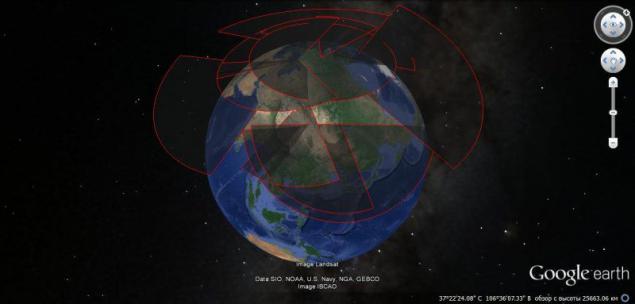
In 1480 the carrier is deployed nuclear warheads since Not all SLBM nuclear submarines equipped with "regular" number YAGCH and cruise missiles X-55 strategic bombers-missile did not deploy at all, and are "in storage facilities," separate from the aircraft. Two years ago, our country possessed 492 deployed strategic carriers, ie, 2, the number of vehicles decreased by 10% the number of nuclear weapons .Sokraschenie Russia continued quite intensively. From 2005 to 2008 utilized 337 ICBM / SLBM. By 2020 it is planned to dispose of 399 ICBMs and SLBMs and 260 Silo / STC. Reduction of Russian nuclear warheads and delivery vehicles goes much more rapidly than envisaged by the agreement with the United States. In addition, in contrast to the American side, our country does not have a significant return potential of nuclear warheads.

MSE UR-100NUTTH 28th Guards Missile Division near Kozelsk
Strategic Rocket Forces are the most formidable and efficient part of the Russian nuclear triad. On the Strategic Missile Forces consist terrestrial mobile intercontinental ballistic missiles and silo-based missiles with nuclear warheads.

MSE P-36 M UTTKh 13th missile division, Orenburg region
As part of the Strategic Missile Forces is 311 missiles capable of carrying nuclear warheads in 1078. Currently in service with the Strategic Missile Forces are 52 heavy missiles R-36M2 (SS-18), 40 of UR-100NUTTH (SS-19), 108 mobile ground complexes Topol (SS-25), 60 complexes Topol-M silo-based (SS -27), 18 mobile systems Topol-M (SS-27) and 33 new mobile missile complex with RS-24 yars.

Topol-M silo, the 27th Guards Missile Army, Saratov region
Strategic Rocket Forces - the only branch of service in the Armed Forces, which is entirely preserved the army-divisional structure, a modified or abolished in other species and genera of troops.

Hangars for mobile RT-2PM "Topol", but "Ozerny" Tver region
Strategic land-based ICBMs as part of the Strategic Missile Forces deployed in the positional areas 11 missile divisions and three missile armies. Strategic Missile Forces Headquarters is located in the village of Vlasikha Moscow region.
As the O-alert ICBM R-36M UTTKh / R-36M2 and UR-100N UTTKh planned to replace them on the RS-24 "yars". It is worth noting that this change is not equivalent. ICBM RS-24 "3 yars carries a warhead, and R-36M2 was set to 10 warheads. In this connection it is planned to develop a new heavy missiles.
As a part of the Russian Navy including 7 SSBN 667BDR and 667BDRM buildings 1979-1990 period.
SSBN TK-208 "Dmitry Donskoy" was upgraded on the avenue. 941UM. The boat used for the testing of the D-30 "Bulava-M", for which two PU altered by ballistic missile R-30. The rest of the SSBN so forth. 941 withdrawn from the fleet.

SSBN "Dmitry Donskoy" pr. 941UM Severodvinsk
January 10, 2013, a solemn flag-raising ceremony on the nuclear submarine of the new generation pr. 955 "Yury Dolgoruky", which marked the transfer of the boat fleet. Ship enlisted in the 31st submarine division of the Northern Fleet, based at Gadzhiyevo.

SSBN ave. 955 "Borey" during the passage of the repair in Severodvinsk, cover open missile silos
The second boat of this type of "Alexander Nevsky" transferred to the Navy 23 December 2013. The ship was enlisted in the 25th Division of submarines of the Pacific Fleet, based in Vilyuchinsk.
The main weapon of these ships is 16 CP of the D-30 missile RSM-30 "Bulava". Range start "Bulava" before the 9300 km. It can carry up to 10 warheads with individual guidance.
Russian strategic missile submarines have two permanent basing points: Gadzhiyevo the Northern Fleet and the Pacific Fleet Fishermen.
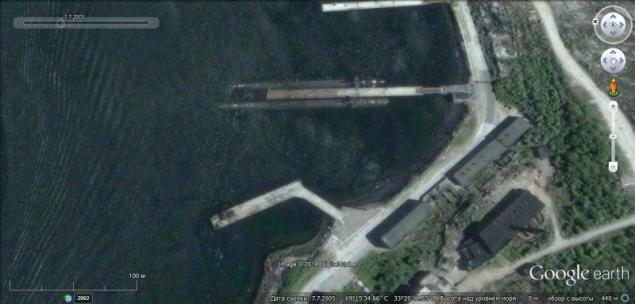
SSBN forth. 667BDRM in Gadzhiyevo
In Gadzhiyevo located on the Kola Peninsula, based in force five SSBNs forth. 667BDRM "Dolphin", which feature a total of 80 launchers ease missile R-29RM.
Nearby is located in Roslyakovo repair facility where the Northern Fleet SSBN are repairs and maintenance.

SSBN forth. 667BDRM in dry dock in Roslyakovo
In fishing, not far from Petropavlovsk-Kamchatsky based nuclear submarines of the Pacific Fleet. There in between the campaigns are two boats so on. 667BDR "Squid". At the moment of missile carriers 667BDR including 32 R-29R.
Also in fishing, on the other side of the bay is a complex maintenance and repair of submarines.

SSBN forth. 667BDR in the fishing
In arsenal of strategic aviation is 66 heavy bombers were armed with approximately 200 long-range cruise missiles. This number includes 11 Tu-160 and 55 Tu-95MS bombers.
Strategic bomber Tu-95MS is equipped with turboprop engines. The bomber has six long-range cruise missiles X-55, placed in the bomb bay. Option bomber, designated Tu-95MS16 may additionally carry up to 10 cruise missiles to be placed on the pylons under the wings, but the range bomber at the same time significantly reduced.
Strategic bomber Tu-160 is the most powerful percussion aviation complex in the world. Strike weapons supersonic bomber consists of 12 long-range cruise missiles X-55 to be placed in the bomb bay. After the ongoing modernization program bombers will be able to carry gravity bombs and non-nuclear cruise missiles.

Tu-95MS and Tu-160 at the airport Engels
The main place of deployment of the Russian long-range aviation is the 6950 th Guards air base in Engels (Saratov region). It includes in its membership the two bomber regiments: the 121st Guards bombers Tu-160 and 184th regiment bombers Tu-95MS.
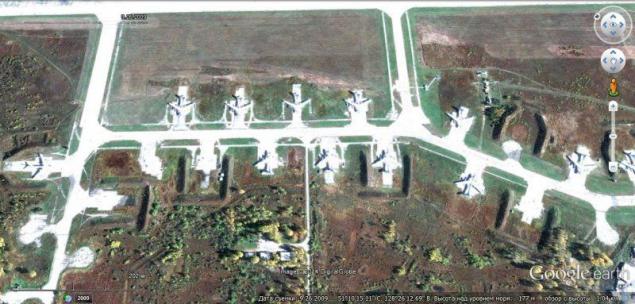
Tu-95MS, the airfield Ukrainka, Amur region
The rest of the Tu-95MS bombers based in the Far East, in the Amur region, in the 6952nd Air Base, located on the airfield Ukrainka.
Traditionally, to include strategic defense - missile defense systems, missile warning, space control.
Information from satellites missile warning is received and processed in real time on the western point of management Serpukhov-15 (Village Kurilovo Kaluga region) and eastern control station, located in Komsomolsk-on-Amur.
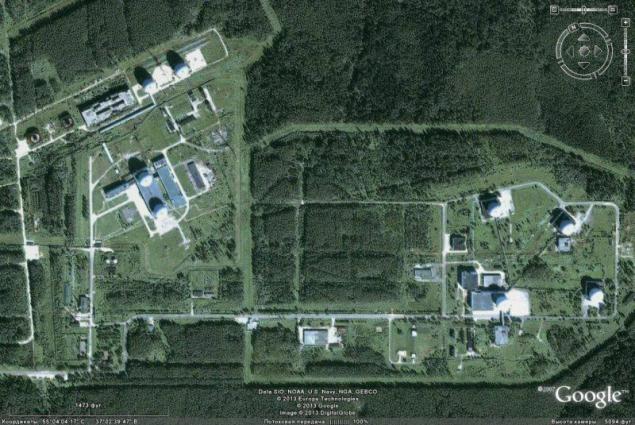
West KP EWS in the Kaluga region
Terrestrial components of early warning system (EWS) are radar control space. It uses radar type "Daryal", "Volga" and "Voronezh».

Radar station "Daryal" in the vicinity of the Pechora
In place of the bulky and old-style energy-intensive stations must come a new generation of radar "Voronezh", which are built in a year and a half (previously required from 5 to 10 years).
The latest Russian radar family "Voronezh" capable of detecting ballistic, space and aerodynamic objects. There are variations, operating in the VHF and UHF. The basis of the radar is a phased antenna array, fabricated module for personnel and several containers with electronic equipment that allows you to quickly and inexpensively upgrade the plant in operation.

Radar Voronezh-M, p. Lekhtusi Leningrad region (object 4524, in / h 73,845)

Voronezh-DM radar, Kaliningrad region
The adoption of "Voronezh" adopted not only significantly enhance the ability of missile and space defense, but also to focus ground grouping of missile attack warning on the territory of the Russian Federation.
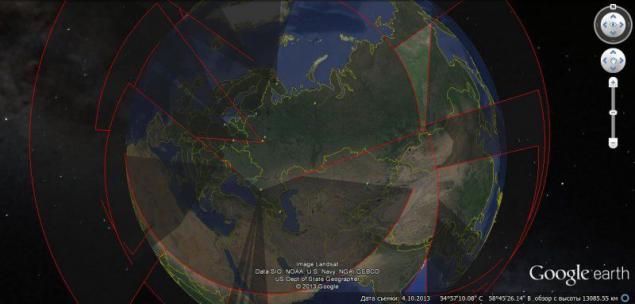
The positions of the radar early warning system and field of view
To cover potentially dangerous in terms of missile attack all areas is planned to put on combat duty 12 radars of this type. The new radar will operate in meter and in the decimeter range, which will expand the capabilities of the Russian system of missile warning. Russian Defense Ministry intends to replace within the state program of armaments to 2020, all Soviet long-range radar detection of missile launches.
Operation of a missile defense system A-135, deployed around Moscow, the division provides a missile. The command-measuring station a missile defense system, combined with the Don-2N radar located in Sofrino Moscow region.

Don-2N radar
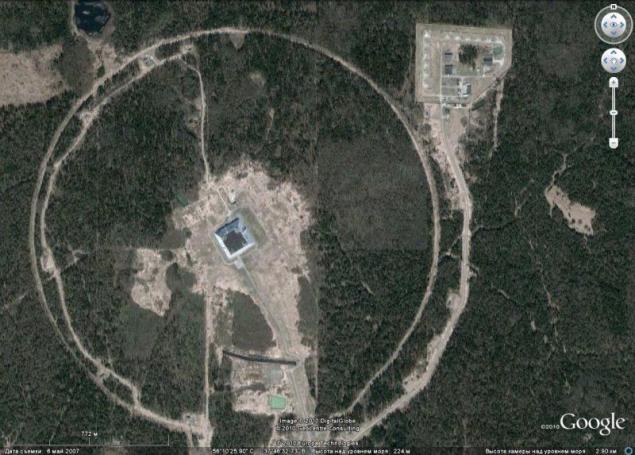
Near the radar located mines missiles 53T6
The system consists of the Moscow missile defense radar Don-2N, command-measuring station and 68 missile interceptors 53T6 (Gazelle), designed to intercept in the atmosphere. 32 missiles 51T6 (Gorgon), designed to intercept outside the atmosphere, removed from the system. Russian missiles, as opposed to the US with a kinetic warhead, fitted with nuclear warheads.
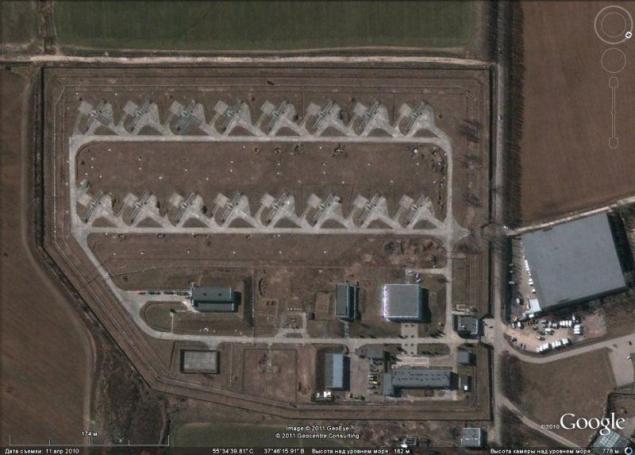
53T6 missile silo in Ascherino
The interceptors are placed in silos arranged in position areas around Moscow. Missile intercept located near a five-position areas - Ascherino (16 launchers), Oboldina (16), Queens (12), Vnukovo (12) and Sofrino (12).

53T6 missile silos at Vnukovo
Missile to intercept long-megaton nuclear warheads were deployed in two parts based in Naro-Fominsk-10 and Sergiyev Posad-15 at the moment they are removed from combat duty and discharged from the mines.

Radar missiles and mines 51T6 Naro-Fominsk-10
The system includes a space control optoelectronic complex "Window" in Nurek (Tajikistan) that allows detection of objects at altitudes of up to 40 000 km. The complex was launched in late 1999. The funds allow for complex data processing, the definition of the parameters of the movement of objects and transfer them to the appropriate command centers.

The complex "Window" in Tajikistan
For this purpose, use the same unit of Radio "Krona" near the village of Watch in Karachay-Cherkessia. As part of the work unit specialized radar UHF and microwave frequencies. The system of "Crown" consists of a radar early warning and optical tracking system. It is intended to identify and track the satellites. The system of "Crown" is able to classify the type of satellite.
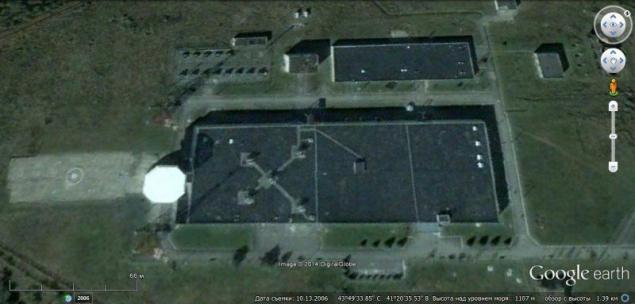
Part of the complex "Crown" with UHF radar, Karachay-Cherkessia
The system consists of three main components:
- Decimetric radar with a phased antenna array for identification purposes
-Radar Centimeter range with a parabolic antenna to the target classification
-Optical System that combines optical telescope with a laser system

Part of the complex "Crown" centimeter radar and laser range finder, Karachay-Cherkessia
The system of "Crown" has a range of 3,200 kilometers and can detect targets in orbit at an altitude of 40,000 kilometers. A similar complex is created in the Far East region of Fokine. The system, placed in the Maritime region is sometimes referred to as "Crown-N», it is presented only UHF radar with a phased antenna array.

The complex system of "Crown" in the Primorsky Territory
Currently, Russia's nuclear forces, the means of space surveillance and missile warning are the guarantor of independence and territorial integrity of the country. They are, in spite of the ongoing process of reforming the armed forces are the most combat-ready and formidable part of them, able to crush any aggressor.
At the same time it should not be a cause for complacency, the processes of degradation, physical and moral aging of equipment and arms raised and this vital part of the Russian army. Against the backdrop of the US national missile defense system and technical improvements to the simultaneous increase in the number of Chinese nuclear weapons, requires the adoption of urgent measures that can fend off new threats and to give a new impetus to the development of Russian strategic forces.
As at 22 June 2013, according to the information within the data exchange under START-3 as part of the strategic nuclear forces (SNF) of Russia was 448 combat-ready (but not necessarily deployed) strategic delivery vehicles, capable of carrying 2,323 nuclear warheads.

In 1480 the carrier is deployed nuclear warheads since Not all SLBM nuclear submarines equipped with "regular" number YAGCH and cruise missiles X-55 strategic bombers-missile did not deploy at all, and are "in storage facilities," separate from the aircraft. Two years ago, our country possessed 492 deployed strategic carriers, ie, 2, the number of vehicles decreased by 10% the number of nuclear weapons .Sokraschenie Russia continued quite intensively. From 2005 to 2008 utilized 337 ICBM / SLBM. By 2020 it is planned to dispose of 399 ICBMs and SLBMs and 260 Silo / STC. Reduction of Russian nuclear warheads and delivery vehicles goes much more rapidly than envisaged by the agreement with the United States. In addition, in contrast to the American side, our country does not have a significant return potential of nuclear warheads.

MSE UR-100NUTTH 28th Guards Missile Division near Kozelsk
Strategic Rocket Forces are the most formidable and efficient part of the Russian nuclear triad. On the Strategic Missile Forces consist terrestrial mobile intercontinental ballistic missiles and silo-based missiles with nuclear warheads.

MSE P-36 M UTTKh 13th missile division, Orenburg region
As part of the Strategic Missile Forces is 311 missiles capable of carrying nuclear warheads in 1078. Currently in service with the Strategic Missile Forces are 52 heavy missiles R-36M2 (SS-18), 40 of UR-100NUTTH (SS-19), 108 mobile ground complexes Topol (SS-25), 60 complexes Topol-M silo-based (SS -27), 18 mobile systems Topol-M (SS-27) and 33 new mobile missile complex with RS-24 yars.

Topol-M silo, the 27th Guards Missile Army, Saratov region
Strategic Rocket Forces - the only branch of service in the Armed Forces, which is entirely preserved the army-divisional structure, a modified or abolished in other species and genera of troops.

Hangars for mobile RT-2PM "Topol", but "Ozerny" Tver region
Strategic land-based ICBMs as part of the Strategic Missile Forces deployed in the positional areas 11 missile divisions and three missile armies. Strategic Missile Forces Headquarters is located in the village of Vlasikha Moscow region.
As the O-alert ICBM R-36M UTTKh / R-36M2 and UR-100N UTTKh planned to replace them on the RS-24 "yars". It is worth noting that this change is not equivalent. ICBM RS-24 "3 yars carries a warhead, and R-36M2 was set to 10 warheads. In this connection it is planned to develop a new heavy missiles.
As a part of the Russian Navy including 7 SSBN 667BDR and 667BDRM buildings 1979-1990 period.
SSBN TK-208 "Dmitry Donskoy" was upgraded on the avenue. 941UM. The boat used for the testing of the D-30 "Bulava-M", for which two PU altered by ballistic missile R-30. The rest of the SSBN so forth. 941 withdrawn from the fleet.

SSBN "Dmitry Donskoy" pr. 941UM Severodvinsk
January 10, 2013, a solemn flag-raising ceremony on the nuclear submarine of the new generation pr. 955 "Yury Dolgoruky", which marked the transfer of the boat fleet. Ship enlisted in the 31st submarine division of the Northern Fleet, based at Gadzhiyevo.

SSBN ave. 955 "Borey" during the passage of the repair in Severodvinsk, cover open missile silos
The second boat of this type of "Alexander Nevsky" transferred to the Navy 23 December 2013. The ship was enlisted in the 25th Division of submarines of the Pacific Fleet, based in Vilyuchinsk.
The main weapon of these ships is 16 CP of the D-30 missile RSM-30 "Bulava". Range start "Bulava" before the 9300 km. It can carry up to 10 warheads with individual guidance.
Russian strategic missile submarines have two permanent basing points: Gadzhiyevo the Northern Fleet and the Pacific Fleet Fishermen.

SSBN forth. 667BDRM in Gadzhiyevo
In Gadzhiyevo located on the Kola Peninsula, based in force five SSBNs forth. 667BDRM "Dolphin", which feature a total of 80 launchers ease missile R-29RM.
Nearby is located in Roslyakovo repair facility where the Northern Fleet SSBN are repairs and maintenance.

SSBN forth. 667BDRM in dry dock in Roslyakovo
In fishing, not far from Petropavlovsk-Kamchatsky based nuclear submarines of the Pacific Fleet. There in between the campaigns are two boats so on. 667BDR "Squid". At the moment of missile carriers 667BDR including 32 R-29R.
Also in fishing, on the other side of the bay is a complex maintenance and repair of submarines.

SSBN forth. 667BDR in the fishing
In arsenal of strategic aviation is 66 heavy bombers were armed with approximately 200 long-range cruise missiles. This number includes 11 Tu-160 and 55 Tu-95MS bombers.
Strategic bomber Tu-95MS is equipped with turboprop engines. The bomber has six long-range cruise missiles X-55, placed in the bomb bay. Option bomber, designated Tu-95MS16 may additionally carry up to 10 cruise missiles to be placed on the pylons under the wings, but the range bomber at the same time significantly reduced.
Strategic bomber Tu-160 is the most powerful percussion aviation complex in the world. Strike weapons supersonic bomber consists of 12 long-range cruise missiles X-55 to be placed in the bomb bay. After the ongoing modernization program bombers will be able to carry gravity bombs and non-nuclear cruise missiles.

Tu-95MS and Tu-160 at the airport Engels
The main place of deployment of the Russian long-range aviation is the 6950 th Guards air base in Engels (Saratov region). It includes in its membership the two bomber regiments: the 121st Guards bombers Tu-160 and 184th regiment bombers Tu-95MS.

Tu-95MS, the airfield Ukrainka, Amur region
The rest of the Tu-95MS bombers based in the Far East, in the Amur region, in the 6952nd Air Base, located on the airfield Ukrainka.
Traditionally, to include strategic defense - missile defense systems, missile warning, space control.
Information from satellites missile warning is received and processed in real time on the western point of management Serpukhov-15 (Village Kurilovo Kaluga region) and eastern control station, located in Komsomolsk-on-Amur.

West KP EWS in the Kaluga region
Terrestrial components of early warning system (EWS) are radar control space. It uses radar type "Daryal", "Volga" and "Voronezh».

Radar station "Daryal" in the vicinity of the Pechora
In place of the bulky and old-style energy-intensive stations must come a new generation of radar "Voronezh", which are built in a year and a half (previously required from 5 to 10 years).
The latest Russian radar family "Voronezh" capable of detecting ballistic, space and aerodynamic objects. There are variations, operating in the VHF and UHF. The basis of the radar is a phased antenna array, fabricated module for personnel and several containers with electronic equipment that allows you to quickly and inexpensively upgrade the plant in operation.

Radar Voronezh-M, p. Lekhtusi Leningrad region (object 4524, in / h 73,845)

Voronezh-DM radar, Kaliningrad region
The adoption of "Voronezh" adopted not only significantly enhance the ability of missile and space defense, but also to focus ground grouping of missile attack warning on the territory of the Russian Federation.

The positions of the radar early warning system and field of view
To cover potentially dangerous in terms of missile attack all areas is planned to put on combat duty 12 radars of this type. The new radar will operate in meter and in the decimeter range, which will expand the capabilities of the Russian system of missile warning. Russian Defense Ministry intends to replace within the state program of armaments to 2020, all Soviet long-range radar detection of missile launches.
Operation of a missile defense system A-135, deployed around Moscow, the division provides a missile. The command-measuring station a missile defense system, combined with the Don-2N radar located in Sofrino Moscow region.

Don-2N radar

Near the radar located mines missiles 53T6
The system consists of the Moscow missile defense radar Don-2N, command-measuring station and 68 missile interceptors 53T6 (Gazelle), designed to intercept in the atmosphere. 32 missiles 51T6 (Gorgon), designed to intercept outside the atmosphere, removed from the system. Russian missiles, as opposed to the US with a kinetic warhead, fitted with nuclear warheads.

53T6 missile silo in Ascherino
The interceptors are placed in silos arranged in position areas around Moscow. Missile intercept located near a five-position areas - Ascherino (16 launchers), Oboldina (16), Queens (12), Vnukovo (12) and Sofrino (12).

53T6 missile silos at Vnukovo
Missile to intercept long-megaton nuclear warheads were deployed in two parts based in Naro-Fominsk-10 and Sergiyev Posad-15 at the moment they are removed from combat duty and discharged from the mines.

Radar missiles and mines 51T6 Naro-Fominsk-10
The system includes a space control optoelectronic complex "Window" in Nurek (Tajikistan) that allows detection of objects at altitudes of up to 40 000 km. The complex was launched in late 1999. The funds allow for complex data processing, the definition of the parameters of the movement of objects and transfer them to the appropriate command centers.

The complex "Window" in Tajikistan
For this purpose, use the same unit of Radio "Krona" near the village of Watch in Karachay-Cherkessia. As part of the work unit specialized radar UHF and microwave frequencies. The system of "Crown" consists of a radar early warning and optical tracking system. It is intended to identify and track the satellites. The system of "Crown" is able to classify the type of satellite.

Part of the complex "Crown" with UHF radar, Karachay-Cherkessia
The system consists of three main components:
- Decimetric radar with a phased antenna array for identification purposes
-Radar Centimeter range with a parabolic antenna to the target classification
-Optical System that combines optical telescope with a laser system

Part of the complex "Crown" centimeter radar and laser range finder, Karachay-Cherkessia
The system of "Crown" has a range of 3,200 kilometers and can detect targets in orbit at an altitude of 40,000 kilometers. A similar complex is created in the Far East region of Fokine. The system, placed in the Maritime region is sometimes referred to as "Crown-N», it is presented only UHF radar with a phased antenna array.

The complex system of "Crown" in the Primorsky Territory
Currently, Russia's nuclear forces, the means of space surveillance and missile warning are the guarantor of independence and territorial integrity of the country. They are, in spite of the ongoing process of reforming the armed forces are the most combat-ready and formidable part of them, able to crush any aggressor.
At the same time it should not be a cause for complacency, the processes of degradation, physical and moral aging of equipment and arms raised and this vital part of the Russian army. Against the backdrop of the US national missile defense system and technical improvements to the simultaneous increase in the number of Chinese nuclear weapons, requires the adoption of urgent measures that can fend off new threats and to give a new impetus to the development of Russian strategic forces.























